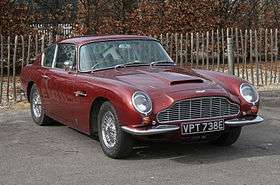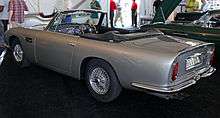Aston Martin DB6
The Aston Martin DB6 is a grand tourer made by British car manufacturer Aston Martin and was produced from September 1965 to January 1971.
| Aston Martin DB6 Aston Martin Volante | |
|---|---|
 1967 Aston Martin DB6 MkI | |
| Overview | |
| Manufacturer | Aston Martin |
| Production | 1965–1970 1,788 produced |
| Body and chassis | |
| Class | Grand tourer |
| Body style | DB6 2-door coupé 2+2 Volante four-seat convertible |
| Layout | FR layout |
| Powertrain | |
| Engine | DOHC Straight six, 3995 cc, 282 bhp @ 5500 rpm 280 lbs-ft @ 4500 rpm |
| Transmission | ZF 5-speed overdrive manual or Borg-Warner 3-speed automatic |
| Dimensions | |
| Wheelbase | 101.5 in (2,578 mm)[1] |
| Length | 182 in (4,623 mm)[2] |
| Width | 66 in (1,676 mm) |
| Height | 53.5 in (1,359 mm) |
| Curb weight | 3,250 lb (1,474 kg)[3] |
| Chronology | |
| Predecessor | Aston Martin DB5 |
| Successor | Aston Martin DB7 |
The DB6 succeeded the Aston Martin DB5 and featured improved aerodynamics and specification over its predecessor.
History and design
After Aston Martin rejected proposals for a replacement for its DB5 from Touring of Milan, the decision was made to focus on their own development car, registered 4 YMC. Wind tunnel testing, begun in February 1965, showed development was necessary to counteract a tendency toward aerodynamic lift [a result of the fastback styling] causing reduced rear-wheel traction at high speed.[4] Final development phases relied upon DB5 chassis, suitably lengthened and titled MP 219, with rear lip-spoiler and abbreviated Kammback tail Aston Martin previously incorporated in sports-racing prototypes. The decision was made to produce MP 219 as the Aston Martin DB6 although the prototype de Dion rear axle was rejected, Aston's soldiering on with its live-axle configuration reducing time to market, cost and complexity.
Introduced at the 1965 London Motor Show, the DB6 was already a dated design[5] notable as the first model engineered following a factory relocation from Feltham to Newport Pagnell. The DB6 has a resemblance to its predecessor, the DB5; with the most noticeable differences being its wheelbase, side profile, split front and rear bumpers and rear panels incorporating the Kammback tail rear end. The tail, combined with the relocated rear-axle and the 3.75-inch (95 mm) lengthened wheelbase, provide more stability at high speed. Though fashionable — the rear-end Kamm-styled design was similar to the Ferrari 250 — it did not prove popular with conservative, tradition oriented Aston clientele when the DB6 was introduced. Performance was satisfactory: road-tests of the day observed top speed of the Vantage model between 145 mph (233 km/h) to 148 mph (238 km/h), with John Bolster aboard a Vantage spec DB6 reaching a two-way average of 152 mph (245 km/h).[6]
The DB6 continued with then high-tech Armstrong Selectaride cockpit-adjustable rear shock absorbers as available on the DB5.[7] Other highlights include adopting front-door quarter windows, an oil-cooler air scoop low on the front valance, quarter-bumpers at each corner, revised tail-lamp clusters; additionally the spoiler affected the overall proportions of the DB6, with an increase in length by approximately two inches.
Other notable changes:
- Roof line raised by two inches improving headroom especially for rear seat passengers
- Genuinely useful leg room for rear passengers
- More steeply raked albeit taller windscreen
- Split front and rear bumpers
- Standard chrome wire wheels on bias-ply whitewall tyres [in USA market]
- Optional power steering
- Optional air conditioning
- Standard ZF five-speed manual unit or a BorgWarner three-speed automatic gearbox available at no extra cost
- Optional Vantage specification retaining triple side-draft Weber 45DCOE carburetors with other minor revisions raising quoted output to 325 hp
Another major change from the DB5 to DB6 was abandonment of the full superleggera construction technique patented by coachbuilders/stylist Touring of Milan. For later DB6's construction, the more common body-on-platform technique was used; this was primarily due to the extended rear requiring a stronger and more rigid design utilizing a folded sheet metal supporting structure. Surprisingly the modifications combined to add only seventeen pounds weight compared to the DB5.[8]
Specifications
.jpg)
The DB6 is powered by the 3,995 cc (243.8 cu in) twin-overhead camshaft (DOHC), in-line six-cylinder Aston Martin engine designed by Tadek Marek. The engine, continued with its triple SU carb setup[9] producing 282 bhp (210 kW; 286 PS) at 5,500 rpm; the Vantage engine option is quoted at 325 bhp (242 kW; 330 PS) against the 314 bhp (234 kW; 318 PS) of the DB5. Although the weight of the DB6 was approximately 17 lb (7.7 kg) heavier than its predecessor, the stability at high speed, added luggage capacity and comforts for passengers in this grand tourer more than offset any imperceptible loss in performance caused by additional weight. The rear suspension used helical coil springs with ride control that was adjustable from inside the car.[10]
- Curb weight: 1,474 kg (3,250 lb)
- Engine: 4.0 L (3,995 cc (243.8 cu in)) straight-6
- Compression ratio: standard=8.9:1 ; Vantage=9.4:1
- Power: 282 hp (210 kW) at 5500 rpm (standard engine)
- Power: 325 hp (242 kW) at 5750 rpm (optional Vantage engine)
- Torque: 400 N⋅m (295 lb⋅ft) at 4500 rpm
- Top Speed: 241 km/h (150 mph)
- 0–60 mph (97 km/h) Acceleration: 8.4 s
- Steering: rack and pinion with optional power assist
- Fuel tank capacity: 19 imp gallons (standard)
16 imp gallons (with optional air conditioning fitted)
Later models and variants


The DB6 Mark II was announced on 21 August 1969, identified by distinct flares on front and rear wheel arches and wider tyres on 1/2" wider wheels. Available as an optional extra for the Mark II was AE Brico electronic fuel-injection combined with the higher compression ratio cylinder head. The Mark II edition shared many parts with the then-new DBS.
As with previous Aston Martin models, a high-power DB6 Vantage was offered. It was equipped with three Weber carburetors and higher compression ratio cylinder head.
A convertible body style was also offered, named the Volante.[11][12] This was introduced at the 1966 London Motor Show. The DB6-based Volante succeeded the earlier (1965–1966) Volantes which were built on the last of the DB5 chassis' and were known as "short chassis" Volantes. Of the later DB6-based Volantes just 140 were built, including 29 high-output Vantage Volante versions, highly prized by collectors.
Charles, Prince of Wales, owns a DB6-based Volante MkII that has been converted to run on bioethanol.[13][14] The car was given to him by his mother on his 21st birthday.[14]
Shooting Brake
A total of six or seven DB6 Shooting-brakes were produced by British coachbuilder Harold Radford, with three more by FLM Panelcraft [15][16] The engine options (282 and 325 hp) were the same as for the DB6 Saloon.
- Kerb weight: 1,587 kg (3,499 lb)
- Overall length: 180 in (4,572 mm)
- Overall width: 66 in (1,676 mm)
- Height: 52 in (1,321 mm)
- Turning radius: 34 feet
- Wheelbase: 98 in (2,489 mm)
- Track: 54 in (1,372 mm)(f)
53.5 in (1,359 mm)(r) - Fuel tank capacity: 16 imp gal (73 L; 19 US gal)
References
- L. A. Manwaring, The Observer's Book of Automobiles (12th ed., 1966), Library of Congress catalogue card 62-9807, pp. 41–43
- Cardew, Basil (1966). Daily Express Review of the 1966 Motor Show. London: Beaverbrook Newspapers Ltd.
- http://storm.oldcarmanualproject.com/astonmartin/Aston%20Martin%20DB6%2013.jpg
- L. A. Manwaring, The Observer's Book of Automobiles (12th ed., 1966) lists the kerb weight (which includes full fuel, cooling liquid and oil) as 3,250 lb
- "Official Aston Martin website history of the DB6".
- Chris Harvey and The Oxford Illustrated Press, Ltd, Aston Martin and Lagonda, Ch.VI, pg. 73, ISBN 978-0-902280-68-7
- Chris Harvey and The Oxford Illustrated Press, Ltd, [Somerset, UK] Aston Martin and Lagonda, 1979; Ch.VI, pg. 70–75,
- C. Harvey and TOI Press, Ltd, Aston Martin and Lagonda, Ch.VI, pg. 69,
- C. Harvey, TOI Press, Ltd, Aston Martin and Lagonda, Ch.III, pg 27,
- Chris Harvey et al Aston Martin and Lagonda, Ch.VI, pg. 72
- http://storm.oldcarmanualproject.com/astonmartin/Aston%20Martin%20DB6%2012.jpg
- Aston Martin DB6 and Volante sales brochure, www.tocmp.org Retrieved on 15 February 2015
- The Observer's Book of Automobiles, Fifteenth Edition, 1969, page 43
- Lienert, Paul (29 April 2011). "Prince William Drives Aston Martin DB6 Away From Royal Wedding". Edmunds Inside Line. Edmunds. Retrieved 16 October 2011.
...the royal couple then surprised the throngs of well-wishers with an impromptu spin around town in Prince Charles's car – a 42-year-old Aston Martin DB6 Volante MkII.
- Brown, Laura Sky (2 July 2008). "Vintage Car: Prince Charles's Aston Martin DB6 Fueled by Wine". Edmunds Inside Line. Edmunds. Retrieved 16 October 2011.
The royal received the car as a 21st-birthday gift from his mother, Queen Elizabeth II, the paper reported. Charles only drives the vehicle some 300 miles per year, but it also averages 10 mpg. Now those gallons are the green kind, bioethanol from biofuel company Green Fuels, which sources it from good old British grapes.
- Peter Hingston (2008). The Enthusiasts' Guide to Buying a Classic British Sports Car. p. 30. ISBN 0-906555-25-6.
- David Dowsey (2007). Aston Martin: Power, Beauty and Soul. Images Publishing. p. 101. ISBN 0-9578759-5-9.
External links
- Car profile at motorbase
- Aston Martin DB6 Mark I Shooting Brake by F.L.M. Panelcraft – information from AMGE Aston Martin German Enthusiasts on www.auto-welt.info